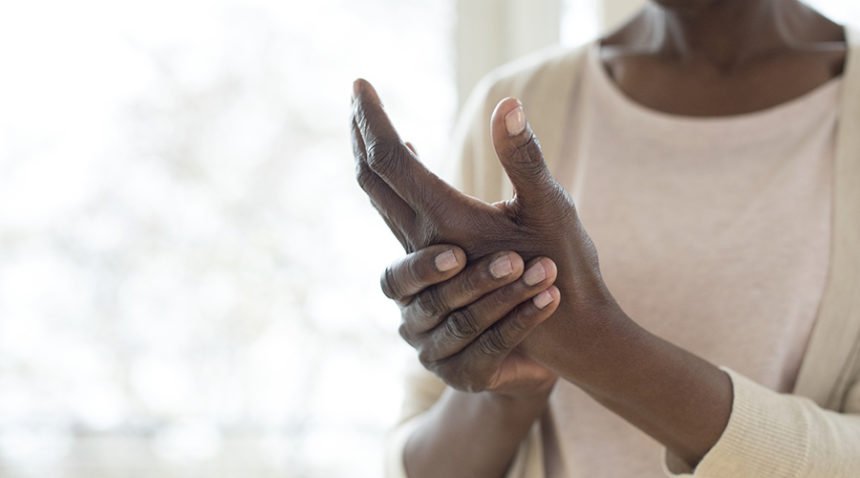Arthritis is very common—affecting nearly 1 in 4 adults in the United States—and debilitating, making it a leading cause of disability.
It’s also not just one condition. The term “arthritis” encompasses more than 100 types of musculoskeletal disorders with different causes and no definite cure.
Understanding more about this disease is the first step in knowing how to manage it. We talked to UNC Health family medicine physician Liza Straub, MD, to learn more.
What is arthritis?
Arthritis is the umbrella term for “pain of one or multiple joints,” Dr. Straub says. “Usually when people think of arthritis, they think of osteoarthritis, which is the most common type. That’s from the typical wear and tear of joints that occurs with age.”
Osteoarthritis is an inevitable part of aging for most people. “More than half of us will have some degree of osteoarthritis by the time we’re 55 or older,” Dr. Straub says.
After osteoarthritis, the most common types of arthritis include rheumatoid arthritis, an autoimmune disease in which the immune system produces substances that attack the joints, causing painful swelling, and post-traumatic arthritis, which develops after an injury.
Spondyloarthritis typically affects the spine and can cause pain and sometimes damage to joints such as your backbone, shoulders and hips.
“Spondyloarthropathies can occur in people who have other inflammatory conditions like Crohn’s disease, ulcerative colitis or psoriasis,” Dr. Straub says.
A less common type of arthritis is septic arthritis.
“This is arthritis that occurs from an infection from bacteria,” Dr. Straub says. Risk factors for this type of arthritis are previous joint replacement, IV drug use, overlying skin infection, and immunosuppression.
Arthritis also can result from Lyme disease or the autoimmune disease lupus. Finally, there is “crystal-induced arthritis,” which includes gout. Gout occurs when a chemical called uric acid builds up in the blood and then deposits as crystals in the body’s joints, fluids and tissues, causing pain, inflammation and swelling, Dr. Straub says.
Children also can have arthritis; it’s estimated that more than 250,000 kids in the United States are affected.
What causes arthritis?
The cause of the arthritis depends on the type. For example, osteoarthritis is caused by aging or trauma, while the causes of rheumatoid arthritis are unknown.
Risk factors for several types of arthritis include:
- Being female
- Being overweight or obese
- Older age (over age 55)
- Previous injury or trauma to the joint
- Family history
- Having a job that requires repetitive bending or squatting
What are symptoms of arthritis?
The most common symptoms of osteoarthritis are pain and stiffness in your joints. If you feel an aching and tightness in your joints after a period of inactivity, such as sitting for a long time, you may have osteoarthritis.
“People with arthritis can have some swelling in the joints, and they can have some popping or cracking that they might hear or sense,” Dr. Straub says.
You may also experience some decreased range of motion of your joints. For example, it may be hard to walk down the stairs if you have arthritis in your knees or hips, or reach overhead if you have arthritis in your shoulders.
“People can have difficulty with fine hand movements if it is in the hands, and then they can sometimes get bony enlargement in those joints too,” Dr. Straub says. If your knuckles seem to be growing, arthritis may be the culprit.
How do you treat arthritis?
If you experience regular joint pain, over-the-counter pain medication such as Tylenol can help, but weight loss and regular exercise are most helpful.
“Regular exercise and weight loss have the best evidence for helping with osteoarthritis and particularly knee osteoarthritis. And that helps with the pain,” Dr. Straub says. “We don’t have great evidence for a lot of other treatments. We do them more just to help people manage their pain.”
For example, a physician can help you identify measures that can relieve pain, such as a knee or hand brace. Another treatment that is now available over the counter and can help with knee and hand arthritis pain is Voltaren gel.
Depending on the severity of your symptoms, you may need to see a doctor for an injection such as a cortisone (steroid) shot into the joint.
If you continue to have pain and injections don’t help or you no longer have any cartilage in your joint, you may be a candidate for joint replacement surgery, in which parts of your joint are removed and replaced with a metal, plastic or ceramic prosthesis.
“If somebody is having progressive pain and disability because of the degradation in that joint, then at some point they may consider a joint replacement,” Dr. Straub says. “But all of that depends on the severity of the pain and the severity of their disability.”
Do your joints hurt? Talk to your doctor or find one near you.

